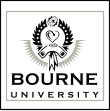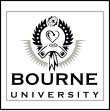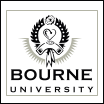© bOURNE uNIVERSITY 2021
CASPIAN SEA TABLETS DECIPHERED TO REVEAL
MIRACLES OF EEMIAN PROPHET
Newham, UK l An English philologist studying a series of ancient tablets known as the Nurubi Fragments recently discovered in the curation vaults of the British Museum's Special Middle Eastern Collections has uncovered what he believes is the first documented accounts of an Eemian prophet named Izal ministering some 130,000 to 100,000 years ago. The priest-scholar recorded the miracles he personally experienced which took place within the prehistoric area of Central and Western Asia now encompassing the Caspian Sea Basin. The extant manuscripts of the writings of the ancient Corean-Itan historian Vol Hom include references to a messianic prophet named "Izal" overthrowing a wicked king and bringing down his powerful sorcerer. Historian and philologist E. R. McCready of the Courtland Institute was retained by the British Museum's Board of Directors to translate, catalog and transcribe some of the most puzzling relics ever excavated from the Assyrian mound of Kouyunjik. Uncovered this year in the curation vaults of the museum's Special Middle Eastern Collection, the Nurubi Fragments were discovered by the English archaeologist Austen Henry Layard in the nineteenth century and stored with the larger collections until a records curator recently discovered the mysterious tablets. Professor McCready team members examining fine CT scanner images of the Nurubi Fragments as extreme wear has nearly eroded the fragile faces If authenticated, he has proposed the tablets- also known as the Miracles of Izal or the Revelations of Izal- be classified as theological scripture from the Eemian. The "Revelations of Izal" is a surviving collection of twenty four square stone tablets each representing an etched illustration of an Izal "miracle" and a historical account of the prophet's work, written on stone in the cuneiform script of Akkadian. The collection also contains the Title Page, the Celestial Alignment Plate, and several maps composed by the priest Vol Hom, where he chronicles the miracles of this prehistoric prophet, as the destruction of the city of Thorum, and the building of the Tomb of Izal (near Zhamysh, Kazakhstan). The pages of the script studied by Professor McCready's examination tells the history that begins in the nation of Comoria (near Lake Sevan, in modern day Armenia). The scholar then records a great prophet rising among the chaos of the city-states and peoples, preaching the gospel of the First Gods and authors the fabled tome called the "Book of Gates." As told by the hagiographer Vol Hom, many of the chronicles portrayed on the tablets are factual events detailing the Caspian ministry of this ancient Commorian-Corean priest, the prophet Izal. Having been banished from Koros (Comoria, modern Armenia), Izal was said to have fled along the southern end of the Caspian Sea to the Zandarian Mountains (near Ashgabat, Turkmenistan), thus escaping the reward of this powerful sorcerer. Izal opposed the dark priest and introduced the worship of the First Gods to the Coreans, whom Vol Hom describes as immense and unimaginable. To the prophet's dismay and disappointment, the enemy sorcerer then rose the Coreans into rebellion, causing the sudden destruction of the Corean people. The Izal and the Astrolabe Plate. Unusual due to the design of Izal, noted as unlike the same Assyrian style as the Nurubi Fragments. Dated about 7500 BC. Believed to be a newer reproduction by a historical Assyrian scholar, the plate seems to convey Izal as a messiah and great priest. The sun design represents the First Gods around the "Dark Star" displayed in the religious concept of worship. Special photo enhancement. Courtesy British Museum Nineveh Collection. E. R. McCready has been reported to be subjecting the tablets these past months to intense forensics in order to legitimatize their origin. The employment of carbon dating, their regional composition of stone, authentic language linguistics and their unearthing among archaeological relics have ruled out the possibility of modern hoaxes. CT scanning techniques have revealed the known method on which the cuneiform was written used a familiar wedge-shaped stylus to make their impressions on the stone surfaces, but dating from 130,000 BC -100,000 BC. The scholar transcribed the text of the Nurubi Fragments during his last months by using those very same primitive techniques, which he then placed in the confines of a cave and then fastened the title page to his stone records to bound the testimony within the tablets. Thousands of years passed before the tablets were discovered, making their way to the Crescent Belt in the migrations of peoples. His works were finally discovered within the Nineveh mound in 1852, which may prove to have been an inspiration for the Mesopotamian civilization. The official and highly anticipated announcement of the findings have been scheduled for a special news conference within the next few months, and could be one of most astounding and shattering discoveries ever revealed. The British Museum Board of Trusties have cautioned the scientific community from speculation on what could be the most significant find in the history of the ancient world, while scholars warn of the possibility of an intricate hoax. Professor McCradey and his forensics team are producing more intense tests and analysis before the final announcement, which could have astonishing historical implications.



THE BOURNE JOURNAL OF
ARCHAEOLOGY








CURRENT ISSUE

Member Since May 1922
Explore
Discover
Find
Catalog
Publish
Reward

LONDON-ROME-BERLIN-MOSCOW-NAPLES


Recent Articles
Proud Sponsor of Bourne’s Journal
Sponsored Works
News of the World






related posts
SHARE ON:
SHARE ON:

© bOURNE uNIVERSITY 2021
CASPIAN SEA TABLETS DECIPHERED TO
REVEAL MIRACLES OF EEMIAN PROPHET
Newham, UK l An English philologist studying a series of ancient tablets known as the Nurubi Fragments recently discovered in the curation vaults of the British Museum's Special Middle Eastern Collections has uncovered what he believes is the first documented accounts of an Eemian prophet named Izal ministering some 130,000 to 100,000 years ago. The priest-scholar recorded the miracles he personally experienced which took place within the prehistoric area of Central and Western Asia now encompassing the Caspian Sea Basin. The extant manuscripts of the writings of the ancient Corean-Itan historian Vol Hom include references to a messianic prophet named "Izal" overthrowing a wicked king and bringing down his powerful sorcerer. Historian and philologist E. R. McCready of the Courtland Institute was retained by the British Museum's Board of Directors to translate, catalog and transcribe some of the most puzzling relics ever excavated from the Assyrian mound of Kouyunjik. Uncovered this year in the curation vaults of the museum's Special Middle Eastern Collection, the Nurubi Fragments were discovered by the English archaeologist Austen Henry Layard in the nineteenth century and stored with the larger collections until a records curator recently discovered the mysterious tablets. Professor McCready team members examining fine CT scanner images of the Nurubi Fragments as extreme wear has nearly eroded the fragile faces If authenticated, he has proposed the tablets- also known as the Miracles of Izal or the Revelations of Izal- be classified as theological scripture from the Eemian. The "Revelations of Izal" is a surviving collection of twenty four square stone tablets each representing an etched illustration of an Izal "miracle" and a historical account of the prophet's work, written on stone in the cuneiform script of Akkadian. The collection also contains the Title Page, the Celestial Alignment Plate, and several maps composed by the priest Vol Hom, where he chronicles the miracles of this prehistoric prophet, as the destruction of the city of Thorum, and the building of the Tomb of Izal (near Zhamysh, Kazakhstan). The pages of the script studied by Professor McCready's examination tells the history that begins in the nation of Comoria (near Lake Sevan, in modern day Armenia). The scholar then records a great prophet rising among the chaos of the city-states and peoples, preaching the gospel of the First Gods and authors the fabled tome called the "Book of Gates." As told by the hagiographer Vol Hom, many of the chronicles portrayed on the tablets are factual events detailing the Caspian ministry of this ancient Commorian-Corean priest, the prophet Izal. Having been banished from Koros (Comoria, modern Armenia), Izal was said to have fled along the southern end of the Caspian Sea to the Zandarian Mountains (near Ashgabat, Turkmenistan), thus escaping the reward of this powerful sorcerer. Izal opposed the dark priest and introduced the worship of the First Gods to the Coreans, whom Vol Hom describes as immense and unimaginable. To the prophet's dismay and disappointment, the enemy sorcerer then rose the Coreans into rebellion, causing the sudden destruction of the Corean people. The Izal and the Astrolabe Plate. Unusual due to the design of Izal, noted as unlike the same Assyrian style as the Nurubi Fragments. Dated about 7500 BC. Believed to be a newer reproduction by a historical Assyrian scholar, the plate seems to convey Izal as a messiah and great priest. The sun design represents the First Gods around the "Dark Star" displayed in the religious concept of worship. Special photo enhancement. Courtesy British Museum Nineveh Collection. E. R. McCready has been reported to be subjecting the tablets these past months to intense forensics in order to legitimatize their origin. The employment of carbon dating, their regional composition of stone, authentic language linguistics and their unearthing among archaeological relics have ruled out the possibility of modern hoaxes. CT scanning techniques have revealed the known method on which the cuneiform was written used a familiar wedge-shaped stylus to make their impressions on the stone surfaces, but dating from 130,000 BC - 100,000 BC. The scholar transcribed the text of the Nurubi Fragments during his last months by using those very same primitive techniques, which he then placed in the confines of a cave and then fastened the title page to his stone records to bound the testimony within the tablets. Thousands of years passed before the tablets were discovered, making their way to the Crescent Belt in the migrations of peoples. His works were finally discovered within the Nineveh mound in 1852, which may prove to have been an inspiration for the Mesopotamian civilization. The official and highly anticipated announcement of the findings have been scheduled for a special news conference within the next few months, and could be one of most astounding and shattering discoveries ever revealed. The British Museum Board of Trusties have cautioned the scientific community from speculation on what could be the most significant find in the history of the ancient world, while scholars warn of the possibility of an intricate hoax. Professor McCradey and his forensics team are producing more intense tests and analysis before the final announcement, which could have astonishing historical implications.


THE BOURNE JOURNAL OF
ARCHAEOLOGY







related posts
SHARE ON:
SHARE ON:


Recent Articles

Sponsored Works
Proud Sponsor of Bourne’s Journal




© bOURNE uNIVERSITY 2021
CASPIAN SEA TABLETS
DECIPHERED TO REVEAL
MIRACLES OF EEMIAN
PROPHET
Newham, UK l An English philologist studying a series of ancient tablets known as the Nurubi Fragments recently discovered in the curation vaults of the British Museum's Special Middle Eastern Collections has uncovered what he believes is the first documented accounts of an Eemian prophet named Izal ministering some 130,000 to 100,000 years ago. The priest-scholar recorded the miracles he personally experienced which took place within the prehistoric area of Central and Western Asia now encompassing the Caspian Sea Basin. The extant manuscripts of the writings of the ancient Corean-Itan historian Vol Hom include references to a messianic prophet named "Izal" overthrowing a wicked king and bringing down his powerful sorcerer. Historian and philologist E. R. McCready of the Courtland Institute was retained by the British Museum's Board of Directors to translate, catalog and transcribe some of the most puzzling relics ever excavated from the Assyrian mound of Kouyunjik. Uncovered this year in the curation vaults of the museum's Special Middle Eastern Collection, the Nurubi Fragments were discovered by the English archaeologist Austen Henry Layard in the nineteenth century and stored with the larger collections until a records curator recently discovered the mysterious tablets. Professor McCready team members examining fine CT scanner images of the Nurubi Fragments as extreme wear has nearly eroded the fragile faces If authenticated, he has proposed the tablets- also known as the Miracles of Izal or the Revelations of Izal- be classified as theological scripture from the Eemian. The "Revelations of Izal" is a surviving collection of twenty four square stone tablets each representing an etched illustration of an Izal "miracle" and a historical account of the prophet's work, written on stone in the cuneiform script of Akkadian. The collection also contains the Title Page, the Celestial Alignment Plate, and several maps composed by the priest Vol Hom, where he chronicles the miracles of this prehistoric prophet, as the destruction of the city of Thorum, and the building of the Tomb of Izal (near Zhamysh, Kazakhstan). The pages of the script studied by Professor McCready's examination tells the history that begins in the nation of Comoria (near Lake Sevan, in modern day Armenia). The scholar then records a great prophet rising among the chaos of the city-states and peoples, preaching the gospel of the First Gods and authors the fabled tome called the "Book of Gates." As told by the hagiographer Vol Hom, many of the chronicles portrayed on the tablets are factual events detailing the Caspian ministry of this ancient Commorian- Corean priest, the prophet Izal. Having been banished from Koros (Comoria, modern Armenia), Izal was said to have fled along the southern end of the Caspian Sea to the Zandarian Mountains (near Ashgabat, Turkmenistan), thus escaping the reward of this powerful sorcerer. Izal opposed the dark priest and introduced the worship of the First Gods to the Coreans, whom Vol Hom describes as immense and unimaginable. To the prophet's dismay and disappointment, the enemy sorcerer then rose the Coreans into rebellion, causing the sudden destruction of the Corean people. The Izal and the Astrolabe Plate. Unusual due to the design of Izal, noted as unlike the same Assyrian style as the Nurubi Fragments. Dated about 7500 BC. Believed to be a newer reproduction by a historical Assyrian scholar, the plate seems to convey Izal as a messiah and great priest. The sun design represents the First Gods around the "Dark Star" displayed in the religious concept of worship. Special photo enhancement. Courtesy British Museum Nineveh Collection. E. R. McCready has been reported to be subjecting the tablets these past months to intense forensics in order to legitimatize their origin. The employment of carbon dating, their regional composition of stone, authentic language linguistics and their unearthing among archaeological relics have ruled out the possibility of modern hoaxes. CT scanning techniques have revealed the known method on which the cuneiform was written used a familiar wedge-shaped stylus to make their impressions on the stone surfaces, but dating from 130,000 BC -100,000 BC. The scholar transcribed the text of the Nurubi Fragments during his last months by using those very same primitive techniques, which he then placed in the confines of a cave and then fastened the title page to his stone records to bound the testimony within the tablets. Thousands of years passed before the tablets were discovered, making their way to the Crescent Belt in the migrations of peoples. His works were finally discovered within the Nineveh mound in 1852, which may prove to have been an inspiration for the Mesopotamian civilization. The official and highly anticipated announcement of the findings have been scheduled for a special news conference within the next few months, and could be one of most astounding and shattering discoveries ever revealed. The British Museum Board of Trusties have cautioned the scientific community from speculation on what could be the most significant find in the history of the ancient world, while scholars warn of the possibility of an intricate hoax. Professor McCradey and his forensics team are producing more intense tests and analysis before the final announcement, which could have astonishing historical implications.



THE BOURNE JOURNAL OF
ARCHAEOLOGY



SHARE ON:
SHARE ON:


Member Since May 1922
Explore
Discover
Find
Catalog
Publish
Reward

LONDON-ROME-BERLIN-MOSCOW-NAPLES



Proud Sponsor of Bourne’s Journal


Like our Sponser





